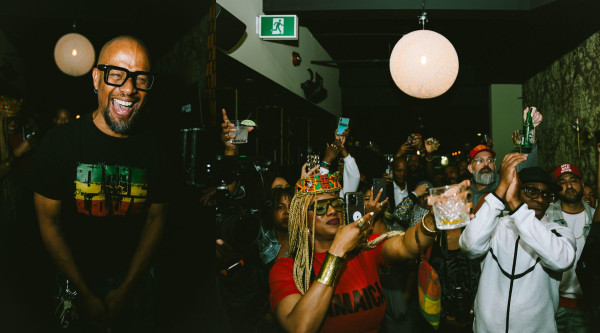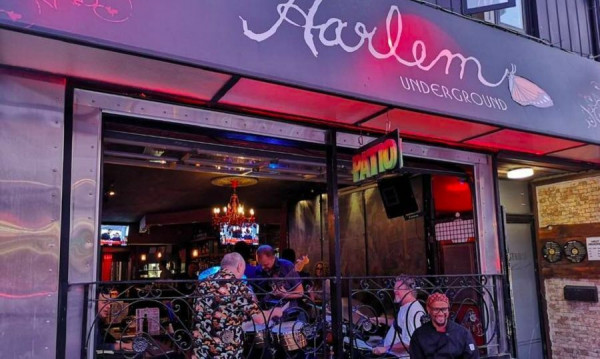Is this the beginning of the end or the end of the beginning?
I weighed the options in my head as I approached the vault-like iron doors leading to the home of restaurant impresario Carl Cassell, the previous owner of Irie and a pair of Southern U.S. Caribbean fusion restaurants named Harlem and Harlem Underground. When the latter closed at the end of 2019, it marked the end of an era in food and hospitality for Cassell, leaving a void in Toronto’s food scene, the Queen West strip, and, more importantly, the city’s Black creative community. This hybrid restaurant slash cultural hub hosted private gatherings and community events and gave local musicians one of the city's few remaining performance spaces. Graffiti on Queen West was still a criminal act when Cassell gave his building over to “vandals” to use as their canvas, years before every storefront and condo developer began “staging cool” on their properties once it was legal to do so.
To picture this place, you had to be there but I’ll offer up some imagery. This is where fried chicken and waffles lived next to jerk chicken on rice and peas. Poetry lived next to jazz layered harmoniously over neo-soul, reggae and house. Some nights, Black music pulled ancestral footwork out of sweat-soaked bodies dancing over floors made sticky with spilled rum. Where the Mayor sanctioned a war between police and public art as Krylon on brick framed what would become Toronto’s “graffiti alley.” This is where we begin with Carl Cassell and his legacy. At the end of something for him that at one time meant everything to everyone else.
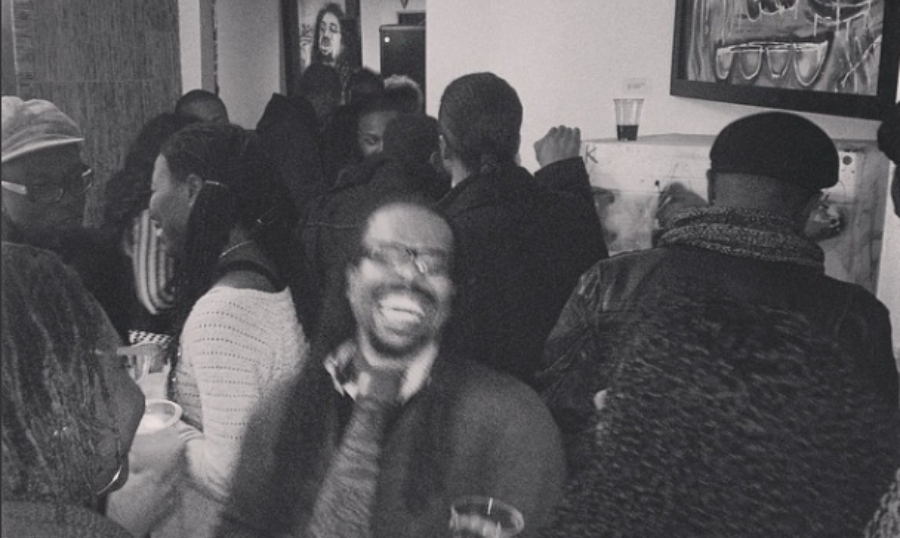
Upstairs at Harlem / Holiday Bash / Credit: Byron Armstrong 2014
Harlem
I am standing in an alley in the middle of a pandemic when Carl Cassell meets me with the COVID-era elbow dap. We’re just two Black men in a urine-scented alley living through a Black Mirror episode before the asteroid hits. Once the vault opens, he leads me up a staircase to his home above his new restaurateur tenants below. I wonder if they understand the relevance of the space they now inhabit? The revolutions that were strategized or Black Canadian art stars who were fed and nurtured here?
His housekeeper has left the windows open, which has allowed for a tiny plague of dead fruit flies to litter his kitchen counter. A thin layer of dust acts as their shallow grave. Cassel goes to work on the microscopic mess immediately, shutting the windows and apologizing as he wipes up the counter until it sparkles. Everything in its proper state, we sit at a long communal table as he pours me a glass of wine and rolls himself a spliff. He unironically bemoans the influx of cannabis dispensaries now cluttering downtown like Starbucks outposts.
“The windows are all frosted up like old porn rental stores and do nothing for the neighbourhood,” says Cassell while scrutinizing his handiwork. “There was a severe lack of innovation on the government’s part.”
Once the thing he’s constructed with his bare hands is built, the builder sets it ablaze.
“I tried the 9 to 5 thing, and it was a spectacular failure,” says Cassell of his life before restaurants. “I’m not a guy that schmoozes about sports over golf and realized fairly quickly that I have nothing in common with these people who essentially live for the weekend. I’d see them losing their minds and money in bars and thought I’d rather be on the other side of that, so I built that life for myself from the ground up.”
A good time to point out the elephant in the room, I ask him for the definitive answer behind the closing of Harlem Underground, the last call for his life as a restauranteur.
“I’d been in it for 20 years, and the day-to-day grind of the restaurant game became all about the restaurant and not about my personal growth anymore,” says Cassell, after a long pause he punctuates with a sigh. It reads as equal parts melancholy and resignation. “A restaurant is like an ungrateful child that you put your all into, and the first chance it gets, it stabs you in the back,” he adds. “Those that understand will always have an exit strategy.”
This is not the answer I want. This is the first thing he’s said, which I’m sure has been said before and sounds entirely reasonable. Twenty years in any industry as tough as the restaurant industry would make anybody weary. Still, it’s hard to believe this is the answer of a man who has helmed three restaurants, with his last being more popular the night it closed than it was the day it opened.
“I’m not this kind of venture capitalist that wants to brand their thing and create a million of them,” Cassell says. “I don’t want to own the world, but I like the act of building something. There’s nothing intrinsically wrong with people who want that, but I wanted time to create.”
Cassell launched Harlem in 2001 just two months before 9/11. Back then, watching the twin towers crumble to dust on a 24-hour news loop had him thinking he’d achieved his life goal at the end of the world. His first degree was in math and economics, which is an interesting combination of skills since creative and mathematical don’t typically exist in the same person. Both halves of his brain began counting his neighbour’s green (organic) bins after coming up with what became known as his “garbage bin index.” The theory supposes a direct correlation between food being sold and food being thrown out as an indicator of social and economic shifts.
“Queen West is one of the most vibrant communities in Canada and is an industry microcosm of the entire country because if it stops eating out, something is seriously wrong with the country,” concludes Cassell.
In the fall of 2018, his index informed him the industry was taking a hit.
“People weren’t eating out, and I think it had a lot to do with higher mortgage rates and the new stress test for approvals, so I sold Harlem East in the middle of that,” Cassell explains.
This left the lesser burden of a single establishment on Queen West to care for. It also points to another x-factor in the Carl Cassell story, a sixth sense that’s helped him navigate his way through life in a way other less intuitive people could only dream of. The recurring theme of this thing others call “luck” has influenced his biggest decisions; an uncanny way of being in tune with his environment and listening to his gut.
“As much as I’d become known as a restaurateur, I tried not to let it become my identity because I’m essentially an artist,” says Cassell. “I was a dutiful father who gave it all the tools to succeed, but by 8 pm, I went home. As time went on, home got closer and closer until I was eventually living on top of the damn thing.”
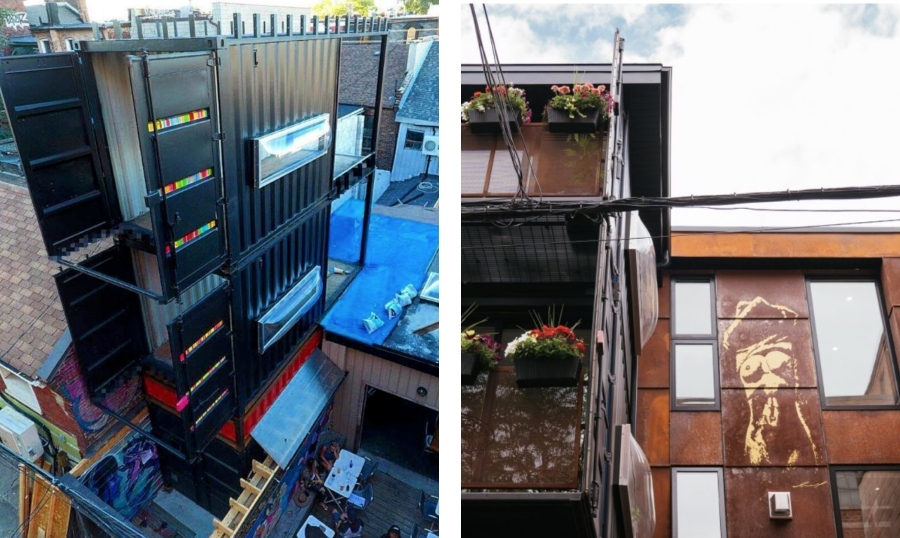
The Black Star under Construction / Post-construction (Metalwork Art by Carl Cassell) / Credit: CarlCassell.com
The Black Star
A good place to pivot, I ask him about that infamous dream project, “The Black Star”, the first shipping container home built of its kind in Toronto, named after The Honourable Marcus Garvey’s famed Black Star Line.
In 2016, The Luminato Festival, an international arts festival dedicated to performance, media and visual arts, wanted to create an outdoor theatre experience with shipping containers. The experience never materialized, but the organizers had already spent hundreds of thousands of dollars to acquire the containers for the project. They ended up just sitting in an area around the waterfront. A year later, Cassell found a pile of tiles from another renovation project while cleaning out his garage. Figuring that he would never use them again, he loaded up his truck with the tiles and drove them over to “a guy” he had just sold a property to. This “guy” turned out to be Anthony Sargent, the CEO of Luminato.
“This English guy was so appreciative of the gesture that he gave me his cell number and told me to call him if I ever needed tickets to any Luminato events,” says Cassell recalling the chance encounter. “One day, I’m down by Lakeshore looking at these 16 containers sitting in a yard, and when I asked a guy working there what they were doing with them, I learned Luminato was paying these guys to store them. When he said that, I remembered I had the cellphone number of the CEO of Luminato and called him up to ask if I could have them.”
The two agreed, and Cassell bought all 16 of them in one shot.
“I built the shipping container home, so I could be closer to the restaurant and my family,” answers Cassell. “What’s become apparent to me is that I enjoy construction and the act of creating with my hands. The reason I got out of Harlem was so I could just do it all the time and perfect it.”
Just like that, he delivers the definitive answer to the question of why he closed Harlem at its height. Yes, he was stressed out, and it was time, but there was also another side of himself he needed to explore. A calling that required him to build other things in different ways. Unbeknownst to everyone on the outside looking in, this cool construct Cassell called home was, in some ways, the beginning of the end.
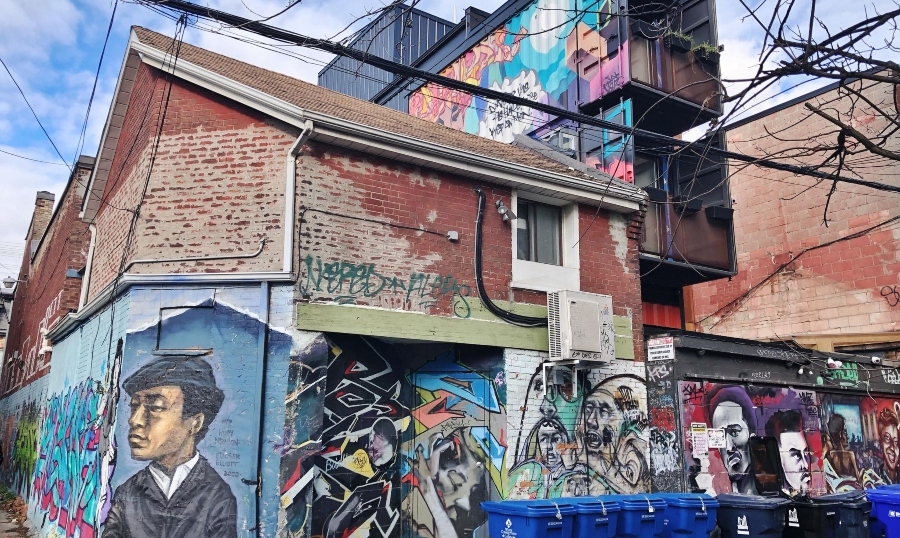
Graffiti Alley behind what used to be Harlem / Wall art by Elicser / Shipping Container art by Javid Jah & Angel Carillo / Credit: Byron Amstrong 2021
Graffiti Alley & Grassroots Movement
“In my 20s, if the cops caught you in these alleyways, they’d beat the shit out of you for defacing property,” Cassell says, remembering the bad old days. “Graffiti alley really started over here.”
In December 2010, Rob Ford, the brother of our current premier Doug, became the mayor of Toronto. Before his cellphone-recorded bouts with addiction and mockery of patois made the city internationally famous for all the wrong reasons, Rob Ford declared war against graffiti artists. As mentioned previously, Carl Cassell allowed the same artists to paint murals on the exterior and even interior of Harlem. It was the exterior work, a mural Cassell commissioned from local street art veteran Elicser, that caught the attention of city hall. Mayor Ford, who wanted the city to remain beige, would have none of it. For context, Elicser had a piece called “The Hug Me Tree” showing at the ROM at the same time the city was demanding his publicly commissioned work be removed.
“The city sent me a letter demanding the Elicser mural be removed or the city would remove it and send me the bill,” Cassell says, still bristling at the memory. “So I wrote them back and told them that the artist whose work they wanted to paint over had work sitting in the ROM, and if they painted over the mural I would sue the city because it’s art.”
Cassell organized a “Fuck Ford” party and handed out 3000 t-shirts emblazoned with the same message to attendees. Even the area's BIA (Business Improvement Association) was against Ford’s demands.
“I and my neighbours set up power, put up lights, and everybody came, partied in the restaurant, and walked through the lit-up alley together,” says Cassell. “Why would we want to paint this over? This alley is an urban gallery.”
Cassell points to incidents like this as how, in many ways, Rob Ford inadvertently helped legitimize graffiti art in this city.
If you’re curious, that Elicser mural is still on the building today.
{https://youtu.be/FpHZzRLnFNk}
A gathering of the Black creative class upstairs at Harlem / Credit: @soul_creatives (Instagram)
The Beginning of The End
“By 2018 the writing was on the wall and I had to start figuring out my exit strategy,” Cassel says. “Then, in 2019, the attention garnered from the shipping container build was insane.”
How insane? Local and international media coverage, as well as documentaries, followed. Being the first Black person to do anything anywhere will always get attention. There’s a natural assumption that at least some will be negative, especially when there are no rules written yet for what that Black person is trying to achieve.
“No one ever wants four building inspectors to walk onto your building site all at once, and being a Black man I took that shit personally. It was the very last day when the building inspector signed off on everything and told me the reason all these inspectors were showing up,” Cassell recalls. “They all just wanted to see the project because it had been on their internal bulletin board for 3 years and they wanted to observe how it was executed for future builds.”
Sometimes natural curiosity trumps racism.
Of course, that kind of publicity also brought locals and tourists to the building who would also eat at the restaurant. If there’s a God, this was it showing a trifling sense of humour. The home Cassell had built as part of his exit strategy had now become the very thing that threatened to entice him to stay.
“In the summer of 2019, I was busy, and in this business when the money comes, you take it,” Cassell says of that time. “It was so good, I started to wonder if I was wrong about leaving the business.”
It’s widely accepted, even by Western medicine these days, that stress attacks the body. For Cassell, a relatively healthy guy, this came in the form of a kidney stone.
“Then I had an epiphany...this thing is killing me,” Cassell says. “I think there’s a sort of cognitive dissonance that people in this industry have and there’s a reason that 80 percent of them fail. Sometimes you’re better off killing it before it kills you.”
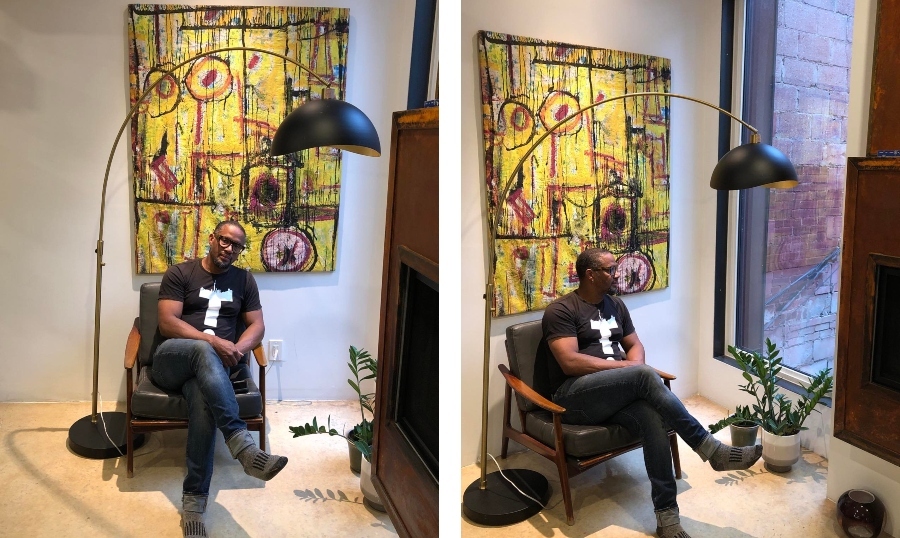
Carl Cassell / Background Art by Leandro Illescas / Credit: Byron Armstrong 2020
Many potential suitors wanted to buy the business and the name, but in the end, he chose to go with his current tenants who wanted to create something new.
“This was a thing that I created with my hands, like when I came into the house with you just now and immediately zoomed in on what was wrong. That’s how I am,” Cassell says, self-examining. “I know if I allowed someone else to fly the Harlem banner, I would judge it, so I said no, don’t do that to yourself.”
Letting Harlem go was Cassell’s way of avoiding the regret of selling his legacy to someone with less respect for it, which inadvertently led to that legacy’s protection.
“I did the same thing with Irie and Harlem East,” Cassell shrugs. “It doesn’t matter how well they’re doing, they have a life. They’re conceived, they’re born, they die, and you move on.”
Once the thing he’s constructed with his bare hands is built, the builder sets it ablaze.
“You’ve got to listen to that crazy fucker in your head. My internal dialogue is so loud that I gave him a name...Carlos,” says Cassell. “Call it the ancestors or intuition, but I’m a very intuitive human being and it’s grounded in reason.”
As if to prove the point, within two months of Harlem’s closure in November of 2019, a strange virus would sweep across the globe. On January 30, 2020, The World Health Organization declared the outbreak a Public Health Emergency of Global Concern. By March 11, 2020, it was declared a pandemic. It unleashed a coronavirus no one had seen before on a global populace, confining them to their homes while crippling the restaurant and hospitality industries.
...and they call it luck.

Artist Shawn Skeir on the swings at Carl Cassell's farm / Credit: Shawn Skeir (Instagram @skeirgallery)
Quinta Beleza: The End of The Beginning
Back in 2013, Cassell bought a large swath of farmland in northern Ontario. “I’d go up to this farm on the weekends and I’d always had a dream to create this for people like me,” says Cassell, whose wife, Anna, also envisioned a yoga retreat. “We figured we could pursue both our dreams, and when I found the containers for such a good deal, I knew I was on the right path.”
By the time Cassell ended Harlem, he already had a plan in place for what he would build in its place. Quinta Beleza would be a communal space and retreat for like-minded, creative people.
“Irie is a truncation of ‘I relax’ from how Rastafarians refer to themselves in the first person like, ‘The I relax’, while ‘Beleza’ is a Brazilian-Portuguese slang word that has the same context as Irie.”
“Quinta” is Portuguese for “farm” which makes the loose translation of Cassell’s retreat something along the lines of “Irie Farms.” As he could have done anything with that property, I was curious to know why an artist’s residency?
“It was that community that convinced me I didn’t have to live a conventional life of working 9-5 to be successful and that I could work four days a week and spend the rest of my time making art,” Cassell says, explaining his motivations. “It comes from the people I’ve been hanging out with and watched come up. It’s the come-up I’d been moving toward artistically before veering off once I opened the restaurant.”
More shipping containers are being stacked at the farm to create an elaborate pool house around a massive 40 x 20-foot pool. Cassell’s plans also include a compound with change rooms, bathrooms and a kitchenette, with an idea to stack them two storeys high around the pool to create tiny homes. The farm itself will be a kind of eco-lodge where you can go for a barefoot walk in the forest and tour the surrounding property. The land is on a river valley that, according to Cassell, has never been touched.
“No one has chopped those trees from the dawn of time till now,” says Cassell. “The forest is old and I have a narrow 54-acre strip of it.”
{https://youtu.be/6qAxFbo_H-4}
Cassell hopes to invite graffiti artists from all over the world to come and paint the containers every year, with rooms that will be themed. Still, he’s not delusional about money. He couldn’t run restaurants for as long as he has without understanding the whole venture needs to pay for itself somehow. As such, the property will be made available for Airbnb rentals and yoga retreats, with a plan to use his old relationships with restaurant industry players to come up and cook for events.
“There are endless possibilities for what this thing can be but ultimately, this is for artists,” assures Cassell. “I have a community that will be there for free to meet, smoke weed, paint, create, and just hang out by the pool for 2 weeks. I feel like I’m the guy that builds the shit that the arts community hangs out at.”
For Cassell, a builder in every sense of the word, the most important thing he has built for others is legacy. A legacy of support for the arts and the community that nourishes it. A legacy of support for movements and people. At 51 years old, Carl Cassell is at neither the beginning of the end nor the end of the beginning.
He’s just right where he needs to be when he needs to be there, and we as a community are much better off for it.
Cassell’s artist residency is a scheduled two-year project he hopes to have completed by 2023. You can keep up with its progress at www.carlcassell.com

 By
By 






